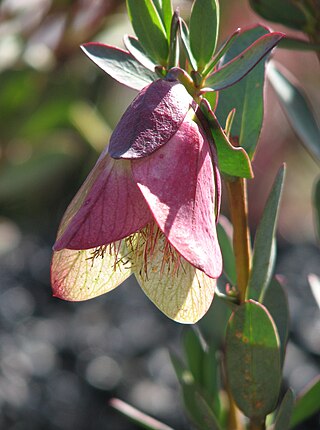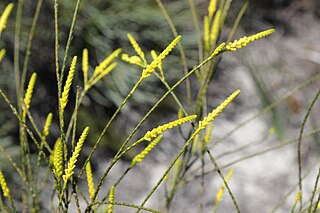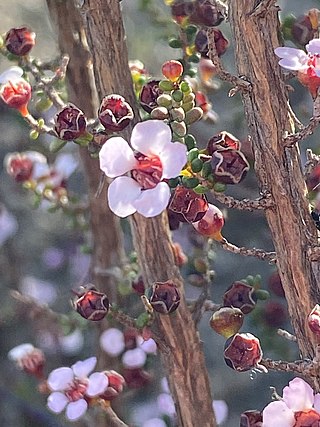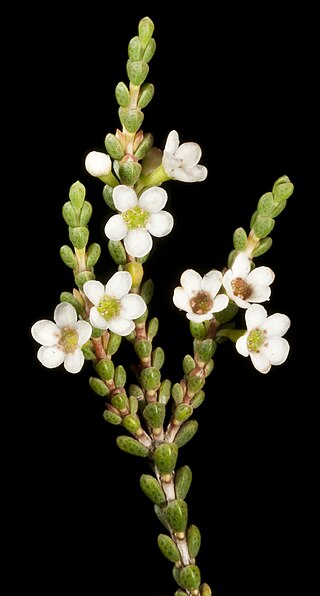
Baeckea is a genus of flowering plants in the myrtle family, Myrtaceae, all but one endemic to Australia. Plants in the genus Baeckea are shrubs or small trees with leaves arranged in opposite pairs, white to deep pink flowers with five sepals and five petals, and five to fifteen stamens that are shorter than the petals.

Verticordia halophila, commonly known as salt-loving featherflower, or salt-loving verticordia, is a flowering plant in the myrtle family, Myrtaceae and is endemic to the south-west of Western Australia. It is an erect, bushy shrub with small, crowded, thick leaves and spikes of red and pink flowers in spring.

Pimelea physodes, commonly known as Qualup bell, is a species of shrub that is endemic to Western Australia. It has egg-shaped to narrow elliptical leaves and distinctive bell-like inflorescences with tiny greenish flowers surrounded by long elliptical bracts. The inflorescence resembles those of some of the only distantly-related darwinia "bells" and the bracts are a combination of red, purple, green and cream-coloured.

Chamelaucieae is a tribe of flowering plants within the family Myrtaceae, mostly from Australia, with a few species in New Caledonia and south-east Asia.

Micromyrtus flava is a species of flowering plant in the family Myrtaceae and is endemic to the south-west of Western Australia. It is a slender, erect shrub with spreading stems, narrowly-elliptic leaves and yellow flowers.

Malleostemon is a genus of flowering plants in the myrtle family Myrtaceae, described as a genus in 1983, by John Green The entire genus is endemic to Western Australia.
- Malleostemon costatusRye & Trudgen
- Malleostemon decipiens(W.Fitzg.) Trudgen
- Malleostemon hursthousei(W.Fitzg.) J.W.Green
- Malleostemon microphyllusRye & Trudgen
- Malleostemon minilyaensisJ.W.Green
- Malleostemon nephroideusRye
- Malleostemon nerrenensisRye & Trudgen
- Malleostemon pedunculatusJ.W.Green
- Malleostemon peltiger(S.Moore) J.W.Green
- Malleostemon pustulatusRye
- Malleostemon roseus(E.Pritz.) J.W.Green
- Malleostemon tuberculatus(E.Pritz.) J.W.Green
- Malleostemon uniflorusRye

Rinzia orientalis, commonly known as desert heath-myrtle, is a species of flowering plant in the family Myrtaceae and is endemic to south-eastern Australia. It is a shrub with elliptic to narrowly oblong leaves and white or pale pink flowers usually with ten stamens.
Balaustion grandibracteatum is a species of flowering plant in the family Myrtaceae and is endemic to inland Western Australia. It is a shrub with mostly narrowly oblong to elliptic leaves and white flowers with 14 to 27 stamens.
Balaustion grande is a species of flowering plant in the family Myrtaceae and is endemic to the south-west of Western Australia. It is a low-growing shrub with oblong or narrowly oblong leaves and usually white or pale pink flowers with 16 to 28 stamens fused in a ring.
Austrobaeckea pachyphylla is a species of flowering plant in the family Myrtaceae and is endemic to the south of Western Australia. It is a shrub with bilaterally flattened leaves and small white flowers with two to eight stamens.

Hypocalymma linifolium, also known as Hypocalymma x linifolium, is a species of flowering plant in the myrtle family Myrtaceae, endemic to a restricted area in the south west of Western Australia. It is a low spreading shrub that with narrowly egg-shaped to almost linear leaves and bright yellow flowers with 22 to 41 stamens in several rows.

Hypocalymma phillipsii is a species of flowering plant in the myrtle family Myrtaceae, and is endemic to a restricted part of Western Australia. It is an erect, spreading shrub with elliptic to very broadly egg-shaped leaves, and white flowers arranged singly or in pairs in leaf axils, with 30 to 50 stamens in several rows.

Micromyrtus elobata is a species of flowering plant in the myrtle family, Myrtaceae and is endemic to the south of Western Australia. It is usually an erect shrub with small, narrowly to broadly egg-shaped leaves with the narrower end towards the base, and white flowers 3–5 mm (0.12–0.20 in) in diameter.

Micromyrtus erichsenii is a species of the family Myrtaceae and is endemic to Western Australia. It is an erect shrub with small, egg-shaped leaves with the narrower end towards the base, and white or cream-coloured flowers 3–4 mm (0.12–0.16 in) in diameter and 5 to 10 stamens.

Micromyrtus redita is species of the flowering plant in the family Myrtaceae and is endemic to the south-west of Western Australia. It is a densely branched shrub with narrowly oblong to elliptic leaves, reddish sepals and white or pink petals.
Thryptomene dampieri is a species of flowering plant in the family Myrtaceae and is endemic to the north-west of Western Australia. It is a low, spreading shrub with prostrate stems, broadly egg-shaped leaves with the narrower end towards the base, and pinkish flowers with five petals and ten stamens.
Babingtonia maleyae, commonly known as the Narrogin babingtonia, is a species of flowering plant in the family Myrtaceae and is endemic to the southwest of Western Australia. It is a compact shrub with narrowly egg-shaped to elliptic leaves and white flowers usually arranged singly in leaf axils, each flower with 17 to 20 stamens.
Babingtonia triandra, commonly known as triplet babingtonia, is a species of flowering plant in the family Myrtaceae and is endemic to a restricted area of the southwest of Western Australia. It is a low, spreading to almost prostrate shrub with linear leaves and white flowers usually arranged in groups of up to 16 in leaf axils, each flower with 3 widely spaced stamens.
Babingtonia urbana, commonly known as coastal plain babingtonia, is a species of flowering plant in the family Myrtaceae and is endemic to the southwest of Western Australia. It is a shrub with linear leaves and white or pale pink flowers usually arranged singly in leaf axils, each flower with 16 to 20 stamens in a circle.

Cheyniana microphylla is a plant in the family Myrtaceae which is endemic to Western Australia.













